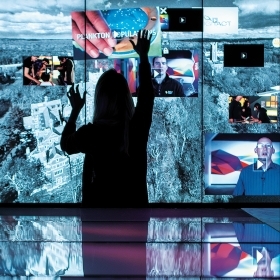Look the future squarely in the face.
In recent months, that has been the daunting charge to a small group of science faculty, working with the Provost’s Office, the College’s facilities team, and architects from Skidmore, Owings, and Merrill in New York. Their project? To develop a vision for a new science center at Wellesley—one that is inviting, flexible, sustainable, and promotes collaborative teaching and research.
In 2016, the Wellesley College Board of Trustees approved a construction plan that includes replacing Sage Hall, the 1931 brick building at the back of the Science Center that has been riddled with infrastructure failures and is structurally inadequate for contemporary science. The 1977 “L-Wing” with laboratories at the front of the complex, and the “E-Wing” at the side, will remain.
In the summer of 2016, the Science Center Faculty Advisory Committee members and their partners began working to develop the program for the new building, considering what elements were necessary to support their vision for teaching science at the College. They spent this past summer on schematic design, focusing on how the necessary elements might fit together within the structure. In the process, the group solicited information from students and academic departments and visited innovative teaching spaces at colleges and universities around the country, ranging from the University of Minnesota to Duke University.
Led by Dean of Academic Affairs Ann Velenchik and Science Center Director Cathy Summa ’83, the advisory group has attempted to look beyond a narrow focus of departmental needs. “We are looking at shared spaces, rather than department-owned spaces,” Velenchik says, “spaces for more kinds of collaboration between students, between faculty, and between faculty and students.” One key component of the building will be the T.T. and W.F. Chao Foundation Innovation Hub, given in honor of the parents of Wellesley trustee Dorothy Chao Jenkins ’68. It will provide laboratory and active-learning and teaching spaces to be used by all disciplines.
“We are trying to create spaces that support and display the myriad ways in which Wellesley students learn through interactions with peers and faculty,” says Nolan Flynn, associate professor of chemistry. “This isn’t simply about classrooms having the latest technology, though that helps. It is about having a palette of classrooms that assist faculty in lecturing effectively with good sightlines and acoustics, in facilitating interactive small-group work, in moving in real time from the theory to the hands-on practice of doing science, some of which are hard, if not impossible, to create in our current building.”
Construction is currently slated to begin in the summer of 2018. While the building is going up, Wellesley will do science in what Velenchik calls “a trailer farm” on a nearby parking lot.
“For 2018–19, we have a plan to take over 100,000 square feet of activity and shove it into 30,000 square feet of trailers,” she says. “That will require flexibility, creativity, cooperation, and probably butter.”







We ask that those who engage in Wellesley magazine's online community act with honesty, integrity, and respect. (Remember the honor code, alums?) We reserve the right to remove comments by impersonators or comments that are not civil and relevant to the subject at hand. By posting here, you are permitting Wellesley magazine to edit and republish your comment in all media. Please remember that all posts are public.